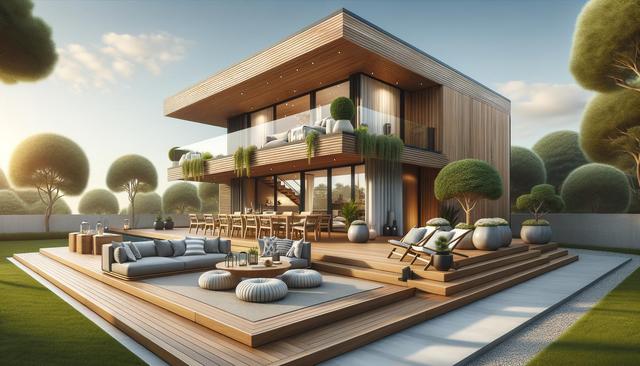Enhance Property Appeal with a Stylish Modern Deck
A modern deck is a practical and stylish way to boost your home’s outdoor living space.

Why a Modern Deck Makes a Smart Investment
Adding a modern deck to your property is more than just a design upgrade—it’s a strategic improvement that can significantly increase your home’s overall value. Homebuyers are increasingly drawn to properties that offer functional outdoor spaces, and a well-designed deck delivers on both aesthetics and usability. Whether you’re preparing to sell or simply want to enjoy your home more, a deck provides a compelling return on investment through improved curb appeal and expanded living space.
Modern decks are often built with contemporary materials like composite wood, aluminum, and tempered glass railings, which not only look sleek but also require less maintenance than traditional wood. These features make the space more attractive to potential buyers who are looking for convenience and durability. Additionally, by incorporating elements such as built-in seating, lighting, and planters, a deck can be transformed into a versatile outdoor area suitable for relaxation or entertaining.
Design Elements That Maximize Value
When planning a modern deck, thoughtful design choices can make a substantial difference in the overall impact. A cohesive design that complements your home’s architecture ensures that the deck feels like a natural extension rather than an afterthought. For example, using similar color schemes or matching materials can create visual harmony between your interior and exterior spaces.
Consider integrating the following design features to enhance functionality and appeal:
- Multi-level decking for defined areas like dining and lounging
- Eco-friendly materials that offer durability and sustainability
- Built-in privacy screens or pergolas for shade and seclusion
- Outdoor kitchen setups or fire pits for added utility
Lighting is another essential element. Subtle, energy-efficient lighting can enhance ambiance and safety, making the deck usable even after sunset. Solar-powered or low-voltage lighting options are ideal for eco-conscious homeowners looking to reduce energy consumption while adding a warm glow to their space.
Choosing Materials That Last
Material selection is a critical decision when it comes to building a deck that not only looks great but also stands the test of time. Composite decking materials are increasingly popular due to their resistance to warping, fading, and mold. These materials mimic the appearance of natural wood while offering superior durability and minimal upkeep.
Other material options include:
- Pressure-treated wood: Affordable and widely available
- Cedar or redwood: Naturally resistant to insects and decay
- Aluminum: Lightweight and corrosion-resistant
Each material has its own set of advantages and considerations. For example, while natural wood offers a classic look, it typically requires regular maintenance such as staining or sealing. In contrast, composite and aluminum materials are more resistant to environmental wear and tear, making them ideal for long-term value and ease of care.
Integrating the Deck with Landscaping
A modern deck should not feel disconnected from the rest of your yard. Thoughtful landscaping can bridge the gap between your home and the natural environment, creating a seamless transition. Incorporating greenery around the deck can soften its edges and provide a more inviting atmosphere. Raised planters, trellises with climbing plants, or surrounding garden beds can all contribute to a well-integrated design.
Here are a few landscaping tips to consider:
- Select native plants for low-maintenance beauty
- Use stone pathways or pavers to guide transitions
- Incorporate water features for added tranquility
- Choose lighting that highlights both deck and garden features
By tying the deck into your overall landscape design, you not only enhance its visual appeal but also extend your usable outdoor space. This integration creates a unified look that enhances the perceived size and functionality of your yard, which can be particularly appealing to prospective buyers.
Permits, Budgeting, and Professional Help
Before breaking ground on your new deck, it’s important to understand the logistical and financial considerations involved. Many municipalities require permits for deck construction, especially if the structure is elevated or attached to the home. Checking local building codes and guidelines will help avoid costly mistakes and ensure the deck is safe and compliant.
Budgeting is another important step. While it may be tempting to cut costs, investing in quality materials and professional installation can save you money in the long run by reducing maintenance and repairs. Working with a professional also ensures that the deck is built to code and designed with structural integrity in mind.
When setting your budget, consider:
- Material costs and availability
- Labor and installation fees
- Permit and inspection costs
- Long-term maintenance expenses
Choosing to work with experienced designers or contractors can help bring your vision to life with fewer complications. Many professionals offer 3D renderings or virtual walkthroughs, allowing you to refine your plans before construction begins. This collaborative approach ensures that the final result aligns with your expectations and adds meaningful value to your home.
Conclusion: A Worthwhile Upgrade for Any Homeowner
Adding a modern deck is a strategic way to elevate your home’s functionality, aesthetic appeal, and market value. From selecting the right materials to integrating landscaping and ensuring compliance with building codes, each step of the process offers an opportunity to enhance your living space. Whether you’re planning to sell or simply want to enjoy your outdoor area more fully, a thoughtfully designed and professionally built deck can make a lasting impact. For homeowners looking to make a worthwhile investment, a modern deck stands out as a valuable addition that combines beauty with utility.